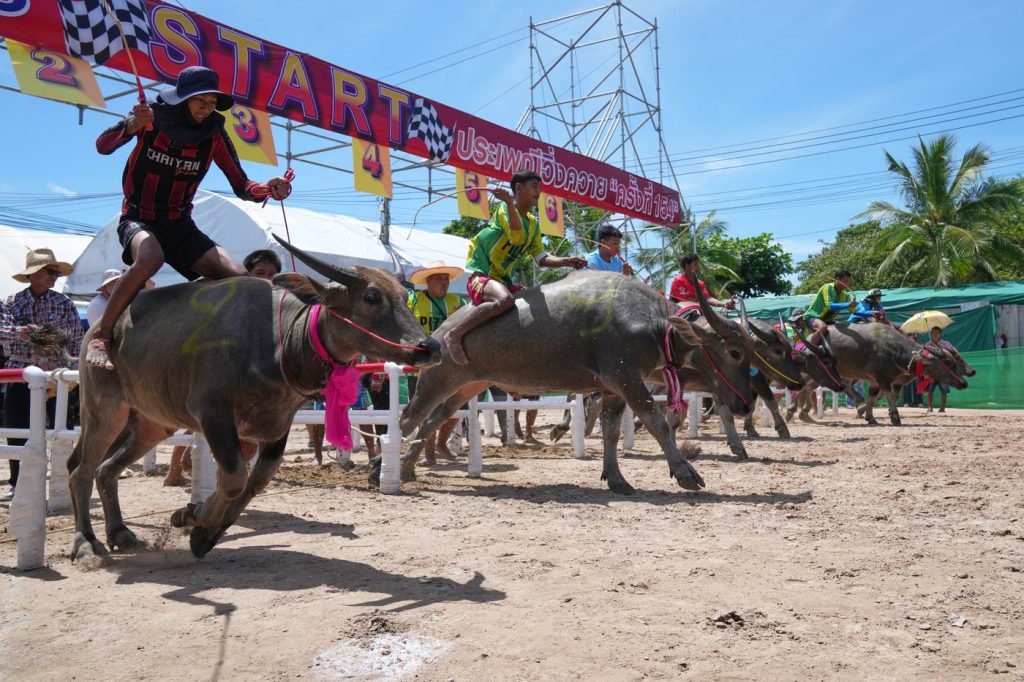CHONBURI, Thailand (AP) — The annual water buffalo racing festival in Chonburi, Thailand, showcased a variety of events, with a special spotlight on beauty contests for these once-humble draft animals. Among the competitors was a 5-year-old buffalo named Tod, who stood out with his bright red ears contrasting against his black fur. Owned by Thawatchai Daeng-Ngam, a food vendor and farmer, Tod participated in this spectacle held roughly an hour's drive from Bangkok.
Historically significant in Thai agriculture, water buffaloes have transitioned from essential laborers to prized show animals. The festival, celebrated at the end of the 11th lunar month, marks the start of the harvest season, highlighting the importance of these animals that were once crucial for farming tasks such as plowing fields and transporting goods. However, with the rise of modern machinery, buffaloes have become less vital on farms, often ending up in meat production if not competing in shows.
The Chonburi festival featured a vibrant parade where students performed traditional Thai dances, while many buffaloes donned flower crowns as they pulled wooden carriages towering at 2 meters (6.5 feet). The event also included thrilling races, where buffaloes ridden by jockeys sprinted down a 100-meter (328-foot) track, attracting excitement from both participants and spectators alike.
Pitun Rassamee entered his white-furred 3-year-old buffalo, Lookaew, who already had a track record of local victories and was aiming for a top-five finish at the festival. The increasing interest in buffalo competitions is underscored by the sale of an albino Thai buffalo in 2024 for a staggering 18 million baht ($672,000)—a clear indication of how valuable these animals have become as show pieces.
The transition of water buffaloes from farm utility to prized status coincided with the mechanization of agriculture in Thailand. Although the buffalo population faced decline during this shift, beauty contests have rejuvenated interest and created a new industry surrounding buffalo breeding, supported by government initiatives. Since 2017, Thailand has observed a National Thai Buffalo Conservation Day, with local authorities assisting farmers with breeding and care practices.
Thawatchai, who views raising Tod primarily as a hobby, allows his buffalo to roam freely on the family farm. In contrast, larger farms tend to bathe their buffaloes daily and provide specialized diets. Kijchai Angkhanawin, a caretaker for notable buffaloes, shared insights on judging criteria, which include horn size, hoof smoothness, and overall physique, emphasizing the care and attention devoted to these animals.
The popularity of buffalo contests is evident to local officials, including Papada Srisophon, who noted that the festival has grown substantially each year. These contests not only motivate farmers to continue raising buffaloes but also provide them with a constructive outlet for their animals, serving as a crucial incentive in a changing agricultural landscape.
At the beauty pageant, participants waited in shaded areas as festival guests took pictures with the majestic animals. Judges clad in bolo ties and cowboy hats scrutinized the buffaloes before announcing the winners. Many owners, like Thawatchai, expressed their deep-seated affection for buffaloes, describing them as family members despite their reduced practical utility in modern farming. “People raise buffaloes, and buffaloes raise people,” he said, highlighting the profound bond shared between humans and these gentle giants.










